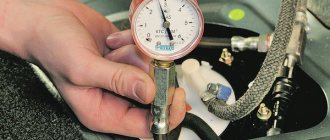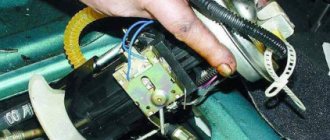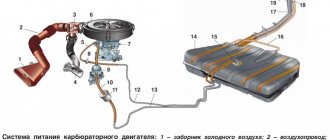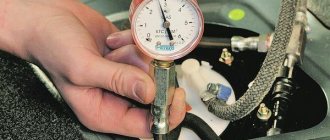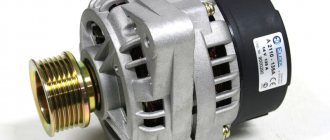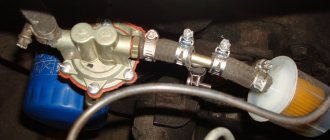HOW THE FUEL SYSTEM WORKS
Fuel is supplied to the ramp under excess pressure (6 atmospheres), which is created by the fuel pump. Using the pressure regulator on the nozzle, a constant pressure drop of 3 atmospheres is maintained. At constant pressure and a linear characteristic of the injectors, the amount of fuel injected is determined by the duration of the injector control pulse.
This is a theory. On a real engine, the pressure drop can be from 2.8 to 3.2 atmospheres. This is an acceptable range within which no deviations in engine operation are observed. Why is pressure variation possible? It is determined by the spread in the characteristics of pressure regulators.
When to change the fuel filter on Priora
As experts advise, you should not wait for the moment when various malfunctions begin to appear in the operation of the Lada Priora with 16 valves, which will certainly lead to the replacement of the cleaning element. It should be taken into account that the filter itself is not expensive at all, and replacing the fuel filter is quite possible even for a person who has no experience in this matter, the main thing is to know where this element is located and follow the replacement instructions. It is best for yourself to set the interval between filter replacements at around 10 thousand km. This is the best option. However, we list the signs that already indicate that it is time to change the filter element:
- The electric fuel pump begins to make a lot of noise. While driving, you are unlikely to hear this noise, but if the 16 valve engine is idling, you may notice a high-pitched buzzing noise. This indicates that the pump is working under increased load.
- So-called failures sometimes occur in the operation of the engine, this is especially felt when acceleration occurs. The reason for this is a clogged cleaning element. Due to a clogged filter, it also happens that the engine stalls, and then it becomes difficult to start.
If you identify such signs, then your Lada Priora needs to replace the fuel filter. A clogged filter always resists the flow of fuel, plus it allows particles of debris to pass through it directly into the injector nozzles. Already there, all this debris settles on the surface and a film is formed from the dirt.
If you clean the injector, the injectors will begin to leak. Most likely, many car owners of the domestic Lada Priora with a 16-valve power unit noticed that after ultrasonic cleaning, the “engine” begins to work worse. And all this is a consequence of the fact that the fuel filter element was not replaced in a timely manner.
Replacing the Priora cabin filter
HOW TO CHECK THE FUEL SYSTEM?
Let's connect the pressure gauge to the fuel rail. With the fuel pump turned on and the engine not running, the pressure should be 2.8-3.2 atmospheres. If the engine is idling, the pressure should drop to 2.2-2.5 atmospheres. When over-gassing, the pressure gauge needle should deviate into the zone of 2.8-3.2 atmospheres.
Now let's check the operation of the injectors. With the engine not running, we will create the required pressure in the ramp (2.8-3.2 atmospheres), after which, using diagnostic equipment, we will apply a series of test pulses to the first injector, monitoring the change in pressure. The above procedure must be carried out for all injectors. The pressure drop should be the same in all cases. If the results of checking the fuel pressure correspond to those described above, the fuel supply system is working properly.
What will happen if the fuel pressure in the rail is low (less than 2 atm.) or high (more than 4 atm.)? The amount of fuel injected will change in proportion to the pressure deviation from the norm. In other words, the air-fuel mixture will become lean or rich.
Checking and replacing the fuel pressure regulator
As you can see, a malfunctioning pressure regulator has symptoms very similar to a malfunctioning fuel pump or a clogged fuel filter. At the very beginning, we note that if problems with this element are detected during the inspection, then it is preferable to replace the RTD with a new one. The fact is that replacing individual parts, cleaning attempts and other manipulations often do not allow the device to return to proper functionality. Considering that the price of a fuel pressure regulator is quite affordable, then any repair attempts can be considered impractical.
Measurements should show changes in pressure in the system within a certain range. The fuel pressure should increase, being within the range of 0.3 - 0.7 Bar. If this does not happen, then first you can try replacing the vacuum hose, and then repeat the measurements. To check the fuel pressure at the end of the ramp, you will need to unscrew the fitting plug. This plug also has a special ring for sealing. The specified ring should be checked for integrity; the element should remain elastic. If there are defects, then the ring or the entire plug also needs to be changed at once.
The VAZ 2107 injector power system has some differences from the classic carburetor. The main distinctive features are caused precisely by the fact that instead of a standard system for supplying the air-fuel mixture to the cylinders, the new VAZ 2107 models use an injector. Accordingly, other elements, such as a pump, filter, etc., differ. In addition to the indicated differences in the fuel system, the VAZ 2107 injection engine has fundamental differences in the ignition system. At the same time, the undeniable advantage of this type of engine is the presence of electronic control of all major systems. It is thanks to it that the efficiency and efficiency of the engine significantly increases.
The schematic diagram of the fuel supply system for the VAZ 2107 injector is shown in the following figure.
Here the main elements are indicated by numbers from 1 to 12:
In addition, the power circuit contains a system for cleaning and subsequent saturation of air with gasoline vapor, consisting of a fuel purge valve 8 and an adsorber 12.
As you can see, the power supply system of the VAZ 2107 injector has a number of significant differences, therefore, the procedure for its maintenance has its own characteristics. As for the air filter, everything is exactly the same as in the case of a carburetor. The filter element is replaced during each routine maintenance.
The pump does not require special maintenance, except for cleaning the fuel strainer installed on the suction pipe. This mesh traps mechanical impurities present in gasoline poured into the tank. If the fuel pump fails, it is replaced. To do this, it is necessary to disassemble the tank, remove the entire pump assembly from it, after which the failed element is replaced. The repaired pump is installed in its regular place in the tank.
FINDING FUEL SYSTEM MALFUNCTIONS
Let us recall the composition of the fuel supply system. It includes: a fuel tank with an installed submersible fuel pump, a fuel filter, fuel lines (supply and drain lines), an injector ramp and a pressure regulator. Any component failure can cause incorrect fuel pressure. Let's try to list common faults for each component.
Gas tank. Through special pipelines, the gas tank communicates with the atmosphere, which prevents its deformation (flattening). If the connection with the atmosphere is broken, a vacuum is created inside the gas tank. In this case, the pressure in the fuel rail may be low.
Gasoline pump. There are several malfunctions:
- the fuel pump does not develop the required pressure, resulting in low fuel pressure;
- the check valve of the fuel pump does not hold pressure, as a result - a rapid drop in pressure after turning off the ignition;
- contamination of the fuel pump mesh filter, as a result - reduced pump performance, which affects the dynamic operating conditions of the engine.
Fuel filter. A dirty fuel filter can lead to low fuel pressure due to reduced fuel line capacity. If the fuel filter is damaged (torn), dirt can enter the injectors with all the ensuing consequences.
Fuel lines. Fuel lines may be pinched. If this happens to the supply line, then the fuel pressure will be reduced, if it happens to the drain line, it will be increased. In addition, the use of low-quality gasoline with a high tar content can lead to a decrease in the capacity of fuel lines.
Causes of fuel pump failure on a VAZ-2110
Contamination of the fuel tank leads to premature failure of the fuel pump.
The main reason that can lead to failure of the fuel pump is poor fuel and a constant low amount of fuel in the tank (5 liters or less).
Incorrect operation of the unit can also lead to unit malfunction. Experts advise that when starting the engine, initially turn on only the ignition for 2-3 minutes and do not turn on the starter. During this time, the pump will pump the required amount of fuel into the system and create a certain pressure there.
The pump may also fail due to natural wear and tear . It usually lasts for a mileage of 150,000 kilometers . This is 4-5 years. But the timing may be different. It all depends on the conditions of its operation.
Burnt contacts of the fuel pump terminal block.
Sometimes a pump failure can be caused by a breakdown in the electrical network, failure of a relay or fuse. Such malfunctions can be quickly eliminated on your own. It's not expensive.
There are craftsmen!
Important! The fuel supply pump can be repaired. This procedure will cost less than buying a new pump. But it’s not worth it (editor’s opinion).
ON-BOARD DIAGNOSTICS FOR FAULT DETECTION
A malfunction of the fuel system leads to a deviation in pressure in the fuel rail. As a result, the amount of fuel supplied to the cylinders differs from the calculated one, and the air-fuel mixture becomes depleted or enriched. In engine management systems with an oxygen sensor, the controller monitors the current composition of the air-fuel mixture.
If the air-fuel mixture deviates significantly from the desired value, the controller perceives this condition as a malfunction, and one of two fault codes is recorded in the controller’s memory:
- P0171 - fuel system too lean;
- P0172 - fuel system too rich.
Increased or decreased pressure in the fuel rail is just one of the reasons why codes P0171, P0172 can be recorded in the controller’s memory. The cause of a significant depletion or enrichment of the air-fuel mixture may be faulty mass air flow sensors, oxygen sensors, or injectors. Air leaks lead to an over-lean air-fuel mixture.
The fuel pressure value may be outside the permissible range, but the on-board diagnostics does not record anything. It’s a very real situation - on-board diagnostics are not omnipotent.
If you find an error, please select a piece of text and press Ctrl+Enter.
1) Good day! I encountered a problem with excess pressure in the GAS TANK. I noticed this phenomenon when opening the tank lid, and a hissing sound was heard. It is excess air, and not a vacuum, that causes the air to escape and cause the smell of gasoline to be felt. Car VAZ 2114 11th year. There is a EURO-3 adsorber, the adsorber purge valve is located on the receiver. Has anyone encountered this problem? Is there a two-way valve in this system? Can it affect the presence of excess air? Is it located? Could the problem be in the gravity valve? Or is the problem in the adsorber itself? The CHECK does not light up and did not light up. Hello, help me with one question, in general I decided to put music in the 2106 Pioneer radio and two speakers on the shelf, so I wanted to install an amplifier and I don’t know which one to get, 2-channel or 4-channel xs and is it worth installing? number of the question you are answering!. Excessive pressure in the gas tank injector VAZ 2110.
How to fix the problem
If you can hear air escaping from the fuel filler flap, you may not always need to fix the problem. In some cases, it may disappear on its own or remain forever if the reason is the characteristics of a given car model. But sometimes a strong sound needs to be eliminated by yourself or in a car service. Typically this requires:
- Replace or clean the fuel filler flap if it is damaged or dirty.
- Clean the outlet tube or gravity channel.
- Change the adsorber.
The last procedure should not be done without a thorough diagnosis of the car, since this element is not cheap for many models. And air can often escape for other reasons. If self-checking is difficult, it is advisable to contact a car service center that inspires trust. They will quickly find the cause and eliminate it for a reasonable fee.
And, of course, you shouldn’t drive with an almost empty tank. And in hot weather, it is recommended to park the car in the shade.
Now you know why the fuel tank cap may hiss when opening and how to eliminate this sound. Have you ever had a similar problem and how did you manage to solve it? If you have any questions or want to share an interesting life hack related to this topic, write about it in the comments.
p0087 error Ford Focus 3
The first thing to do is check the pressure produced by the pump located in the fuel tank. It should be stable at 5-6 bar. It is not difficult to check by connecting to the ECU. If the pressure is below normal, check the pump filter and pipes for clogging or replace the entire assembly.
Next, we look at the sensor located in the high pressure rail. If it is faulty, then the rail may have standard pressure (20 bar), and the ECU will receive other indicators that do not coincide with the standard ones, which will cause an error.
Conversely, with a working sensor, the pressure in the rail itself may be less than 20 bar, for example, 5 or 6. This can be caused by a number of problems listed below.
If replacing the sensor in the rack does not help, then remove the high-pressure pump and visually check its condition. The presence of obvious defects and severe wear of the sliding pairs indicates that it is time to change the unit.
If everything is normal, then pay attention to the pump spring. It should stand rigidly and be difficult to compress with a vice (we are not talking about hands and pliers at all)
Its size in the expanded position should be 22 mm. If it is less, for example, 16 mm, then replace the entire assembly.
To check whether the spring is performing its functions, remove the injection pump, engage the gear and roll the car (jack up the front wheel and turn it) until the cam on the camshaft is in the maximum position to the location of the pump.
Place the pump in its normal place; if it does not shrink, then everything is normal; if, on the contrary, it becomes free, then the spring is shortened and the plunger does not reach the glass, thereby not creating the required pressure in the system. The sensor reacts to this, which leads to error p0087.
How to measure
All you need is a pressure gauge, which is designed to measure tires. It just needs to be modified a little by changing the scale. It is better to measure the pressure in the injection system with a device scale showing a variation within 6-7 atm.
There are other, more advanced measuring instruments. A special tool kit with a pressure gauge, adapter and drain hose is sold at an auto parts store. Costs about 1.5 thousand rubles.
Pressure can be measured at any car service center. They will charge nothing for the service - 500-600 rubles.
Professional pressure gauge for measuring fuel
But whatever one may say, an experienced motorist should have his own pressure gauge among his tools. If it is purchased, then with it the driver receives all kinds of adapters that allow pressure measurements on a wide variety of car brands. In addition, commercial pressure gauges are equipped with a better scale that allows you to measure pressure more accurately. And a professional pressure gauge is generally a godsend, since it makes it possible, among other things, to relieve residual pressure in the system, which increases the accuracy of the readings.
If you decide, nevertheless, to use a homemade pressure gauge, then remember!
It is better to use a regular air pressure gauge from VAZ, since it can also measure oil pressure (you just need to unscrew the fitting). Instead of an adapter, you can use a regular threaded fitting. It is important to use high-quality clamps so that there are no gaps.
How to take measurements.
- Most often they are carried out with the ignition on. It is necessary to check whether the arrow has jumped in comparison with the standard value.
- Measurements are also carried out in XX mode.
- Measurements are carried out with the “return” compressed and with the RTD reset.
How to reduce the pressure in the power system of a fuel-injected car?
Note! Before you start, you should definitely know that in the fuel injection power system the pressure is 30 MPa (3 kgf/cm2). Based on these values, always remember that under no circumstances should you loosen the connection of the high-pressure fuel pipes while the car’s engine is running, or immediately after stopping it. But there is one interesting factor: after the car has been turned off and left unstarted for two to three hours, there is no need to reduce the pressure in the system at all, since during this time it itself drops to almost zero and rises sharply after starting engine!
1) In order to reduce the pressure, first open the hood of the car and then find the control valve in the engine compartment, which will still be closed with a protective cap that is very similar to a wheel nipple cap.
2) After the protective cap is found, take it and turn it completely by hand and after unscrewing the cap, a control valve will appear before your eyes, in the center of which there will be a spool (Indicated by an arrow), you will need to press on this spool using which be it with an awl or a screwdriver, or even with a wrench.
